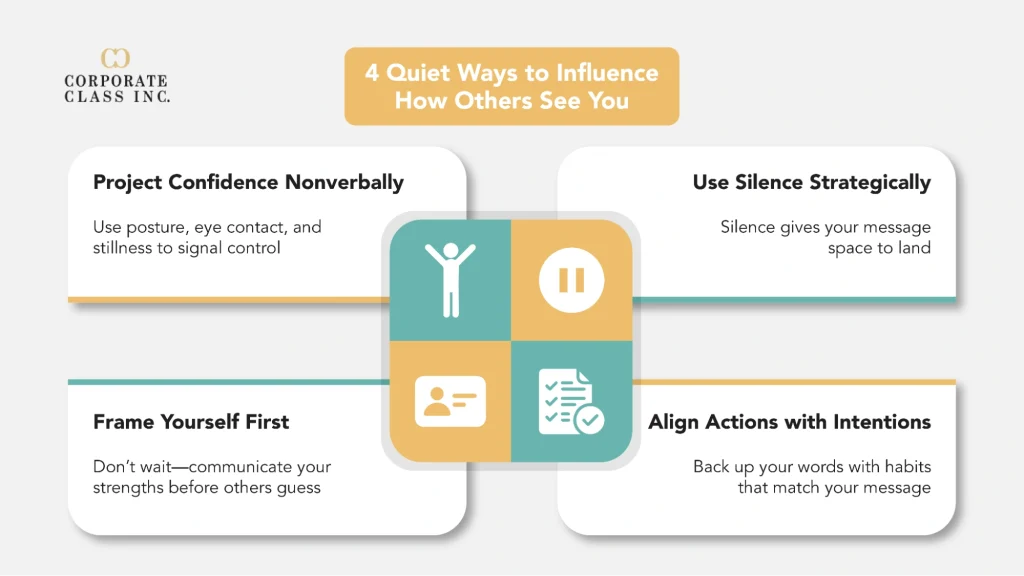Perception management is the practice of shaping how others see you, intentionally, consistently, and often silently. It’s not about pretending. It’s about guiding interpretation. You don’t need to speak louder to have more influence. You need to manage how your presence, actions, and choices are read by others.
Key takeaways:
- Perception management helps you shape how others interpret your actions, not just your words.
- Strong perception is built on consistent, strategic cues aligned with your goals.
- Influence grows when perception matches intention and supports credibility.
What is Perception Management?
Perception management refers to the process of influencing how others view you, your actions, or your brand. It draws from psychology, communication, and leadership to help you control the narrative around your image. You don’t leave this to chance. You guide it deliberately.
This isn’t manipulation. It’s alignment. You identify how you want to be perceived and ensure your behaviour, tone, and presence reflect that vision. This gives others less room to misinterpret you and more clarity about your value.
Ready to Upgrade How You're Perceived at Work?
Sharpen your presence. Build silent influence.
Perception Management Key Principles
Managing how others perceive you starts with understanding what perception really means. It’s not a fixed truth. It’s an interpretation, a mental shortcut people take to assess your actions, tone, and presence. Perceptions form fast, often within seconds, and once they set in, they guide how others treat you, include you, and believe you. Below are three foundational ideas that guide effective perception management.
Perceptions are Not Absolute Truths
What people see isn’t always what you meant. A raised eyebrow might seem like doubt. A delay in response may feel like disinterest. Most people don’t engage with your full intent, they engage with how they interpret your signals.
This is why awareness matters. You need to notice how others respond, not just what you say. Your tone, eye contact, and timing send cues. If those cues don’t match your intention, your message gets lost in translation. Perception management means closing that gap, removing friction between how you act and how others receive it.
Success is a Function of Both Performance and Perception
Strong results are necessary. Strong signals are essential. You may work hard behind the scenes, but if people don’t see your value, they may overlook your impact. This doesn’t mean self-promotion. It means presentation with a purpose.
Think of performance as the foundation and perception as the framing. You can build a strong house, but it needs clean windows and lighting to be appreciated. Strategic updates in meetings, clear summaries of your work, and well-timed questions all help shape the way your efforts are understood.
Authenticity Matters
People notice when you’re forcing a persona. You may get short-term attention, though trust often fades. Perception management works best when it reflects a real, grounded version of you, one that highlights strengths and stays consistent across different settings.
Being authentic doesn’t mean being fully transparent or casual at all times. It means showing up with purpose and aligning your words, tone, and choices with your values. Over time, that builds trust. And trust is what makes your influence sustainable. Your strengths don’t need embellishment. They need exposure with clarity and consistency.
Influencing Perception Management Effectively

Perception is shaped through signals, some loud, many silent. Influence grows when your cues match the image you want others to hold. Below are four key strategies for managing perception in practical, sustainable ways.
Project Confidence and Authority Nonverbally
Before you speak, you’re already communicating. Posture, facial expressions, and eye contact tell people how seriously to take you. A confident stance creates instant credibility.
Slow movements and a calm pace signal control. Even your pauses carry weight. Treat them as tools, not gaps. Authority isn’t always loud, it’s often still and sure.
Frame Yourself Before Others Do
If you don’t define your strengths, others will guess. That guess may be wrong. You shape perception by consistently reinforcing how you add value.
In conversations, introduce yourself with intention. Focus on impact, not titles. When you leave a room, people should know your role, your voice, and your value.
Use Silence and Presence Strategically
You don’t need to fill every silence. Strategic pauses create space for others to reflect, and for your message to land. That silence becomes part of your communication.
Presence also matters. Eye contact, stillness, and listening create impact. You don’t have to speak more, you have to show that you are paying attention and thinking clearly.
Align Actions With Desired Perceptions
Every action is a signal. If you want to be seen as dependable, show up consistently. If you want to be seen as a strategist, ask thoughtful questions and connect ideas.
Perception breaks when your behaviour sends mixed messages. Choose habits that match the identity you want to communicate. That consistency speaks louder than slogans.
Influence Starts with How Others See You
Master perception. Lead without overexplaining
FAQ
Is perception management the same as manipulation?
No. Perception management is about alignment, not deception. It focuses on guiding interpretation, not creating false impressions.
Can perception management help in job interviews?
Yes. Interviews are high-stakes perception moments. Framing your experience clearly and projecting calm confidence helps influence how you’re remembered.
Do you need to be extroverted to manage perception well?
Not at all. Perception management relies more on intentionality than volume. Introverts can use silence, clarity, and precision to shape how they’re viewed.
Final Thoughts: Influencing How Others See You with Perception Management
Perception management gives you control over how you’re seen, even when you say very little. It combines intention, clarity, and consistency into a quiet form of influence. You don’t need to change who you are. You need to show others the best version of what’s already true. That’s how perception works in your favour.
Don’t Just Work Hard - Be Recognized for It
Align visibility with your true impact.





